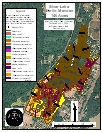Silver Lake, Berlin - 2004
2004 Aquatic Plant Survey Map of Silver Lake
Silver Lake, also known as Peat Works Pond, has an area of 146 acres, a maximum depth of 16 feet, and a mean depth of 5 feet. Private homes and the Berlin Turnpike border the eastern side. A railroad track runs through woods on the west side of the lake. The lake has a state boat ramp but no public swimming access. Mercury contamination has led the Connecticut Department of Public Health to issue a fish-consumption warning for the lake. The lake was dredged several years ago to harvest peat and to reduce the growth of aquatic plants. One resident said the dredging greatly reduced the abundance of plants but that the lake had been even more free of weeds during the 1950s.
A July 2004 survey found that Silver Lake supports a community of 14 aquatic plants, which includes two floating-leaved species and three invasive species. The floating-leaved yellow water lily (Nuphar variegata) was found to be most abundant in shallow water around the sides of the lake. Eurasian watermilfoil (Myriophyllum spicatum), an invasive species, and coontail (Ceratophyllum demersum) were most abundant in deeper water. Other species that were recorded included slender naiad (Najas flexilis), the invasive minor naiad (Najas minor), Canadian waterweed (Elodea canadensis), flat-stemmed pondweed (Potamogeton zosteriformis), small pondweed (Potamogeton pusillus), the invasive curlyleaf pondweed (Potamogeton crispus), large-leaf pondweed (Potamogeton amplifolius), water smartweed (Polygonum amphibium), eelgrass (Vallisneria americana), and the floating-leaved white water lily (Nymphaea odorata).
Eurasian watermilfoil was most abundant in the narrow, northern end of the lake, where a dam is located. Yellow water lily was abundant along the western shore of the area, and slender naiad, coontail, Canadian waterweed, small pondweed, and flat-stemmed pondweed also were recorded there. No plants were found in water more than 6 feet deep. Yellow water lily was most abundant along the western shore of the lake, and water smartweed occurred in large patches at the southern end of the shoreline. Eurasian watermilfoil became more abundant in deeper water, occurring with coontail. Canadian waterweed was found in large patches and flat-stemmed pondweed, small pondweed, curlyleaf pondweed, large-leaf pondweed, and slender naiad occurred in smaller patches.
The most abundant species on the eastern side of the lake was Eurasian watermilfoil. Yellow water lilyalso was abundant, occurring with three floating-leaved duckweed species: great duckweed (Spirodela polyrhiza), common duckweed (Lemna minor), and watermeal (Wolffia species). Coontail was found in large patches, while Canadian waterweed, water smartweed, flat-stemmed pondweed, small pondweed, eelgrass, and pipewort (Eriocaulon species) occurred in smaller patches. Curlyleaf pondweed occurred in a large patch with smaller patches of Eurasian watermilfoil and small pondweed in the middle of the northern half of the lake, where the water was 2 to 6 feet deep. The middle of the southern half of the lake, where the water reached a depth of 10 feet, was dominated by Eurasian watermilfoil with large patches of coontail. Yellow water lily was abundant around the southern and western edges of an island in the lake’s southern end, and the lake’s only patch of white water lily was recorded on the eastern side of the island.
| Species recorded in our 2004 survey of Silver Lake. Scientific Names *Invasive Species |
||
| Canadian waterweed | Flat-Stemmed pondweed | Small pondweed |
| Coontail | Large-Leaf pondweed | Water smartweed |
| Curlyleaf pondweed* | Minor naiad* | White water lily |
| Eelgrass | Sevenangle pipewort | Yellow water lily |
| Eurasian watermilfoil* | Slender naiad | |


